What part of the nervous system performs information processing and integration?
central nervous system
parasympathetic nervous system
somatic nervous system
sympathetic nervous system
central nervous system
Which of the following is NOT one of the basic functions of the nervous system?
control the activity of muscles and glands
monitor changes occurring both inside and outside the body
regulation of neurogenesis
integration of sensory input
regulation of neurogenesis
Which of the following allows us to consciously control our skeletal muscles?
the parasympathetic division of the autonomic nervous system
the sympathetic division of the autonomic nervous system
the somatic nervous system
the afferent division of the nervous system
the somatic nervous system
Cold sores on the skin of the mouth occur when herpes simplex viruses that are dormant in neural ganglia become active and travel to the skin of the mouth. Which of the following is the mechanism by which these viruses travel from the ganglia (located within the head) to the skin of the mouth?
transport along nerve impulses that travel down the axons
anterograde transport
retrograde transport
travel of the viruses along neurofibrils
anterograde transport
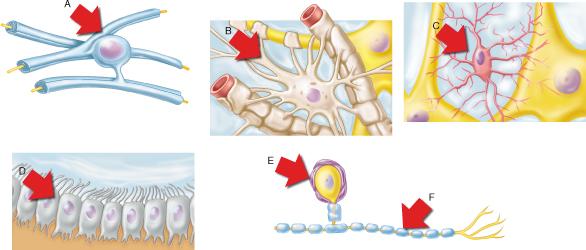
Which of the neuroglial cell types shown is the most abundant in the CNS?
B
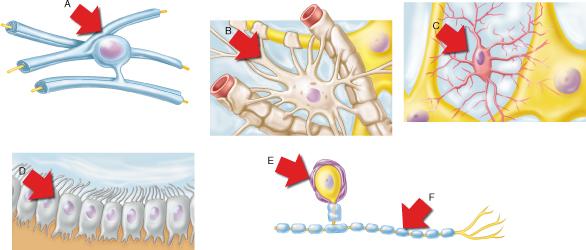
Which of the neuroglial cell types shown control the flow of cerebrospinal fluid within the CNS?
D
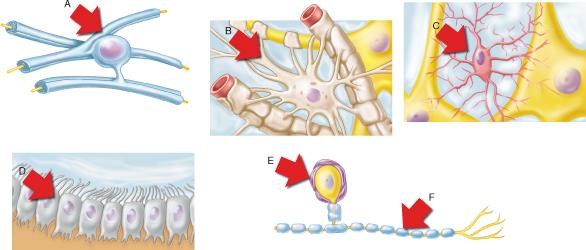
Which of the neuroglial cell types shown form myelin sheaths within the CNS?
A
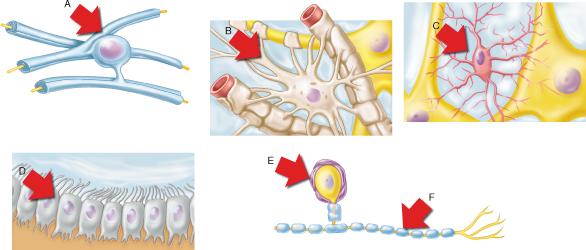
Which of the neuroglial cell types shown are found in the PNS?
E
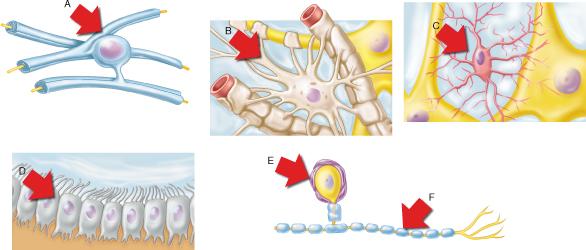
What structural classification describes the neuron associated with the neuroglia shown by E and F?
Unipolar
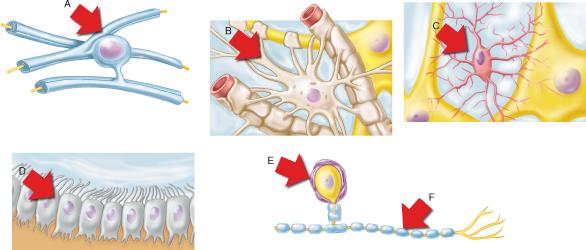
Destruction of which of the neuroglial cell types leads to the disease multiple scleroses (MS)?
A
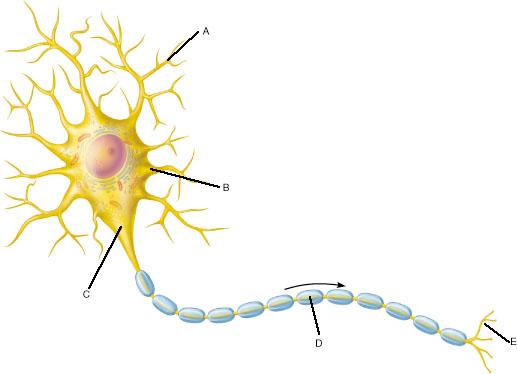
Which lettered region in the figure is referred to as the soma?
B
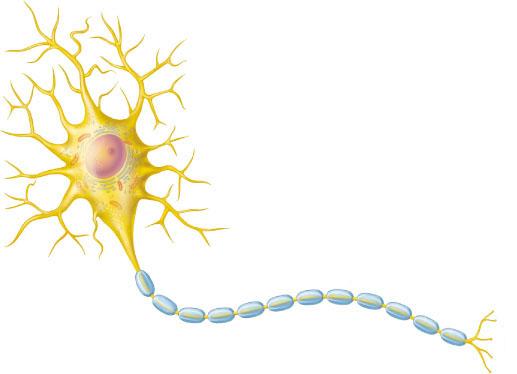
What structural classification describes this neuron?
Mulitpolar
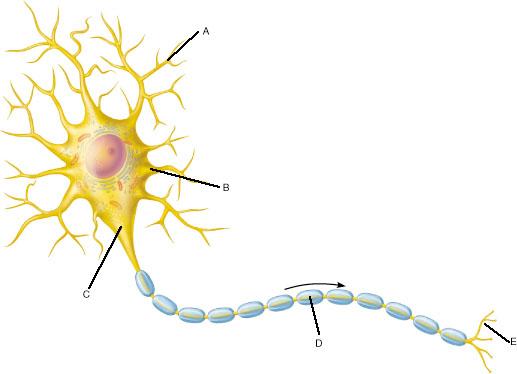
Which areas of this neuron would be classified as receptive regions?
Both A and B
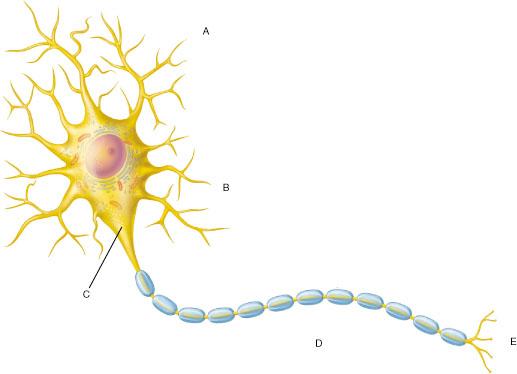
Which area would contain an abundance of vesicles containing neurotransmitter?
E
Which neuroglia are the most abundant and versatile of the glial cells?
ependymal cells
astrocytes
Schwann cells
oligodendrocytes
astrocytes
Which part of the neuron is responsible for generating a nerve impulse?
chromatophilic substance
soma
dendrite
axon
axon
Which of the following types of neurons carry impulses away from the central nervous system (CNS)?
sensory
association
afferent
motor
motor
Which of the following types of glial cells monitors the health of neurons, and can transform into a special type of macrophage to protect endangered neurons?
ependymal cells
astrocytes
microglia
oligodendrocytes
microglia
Which of the following types of glial cells produces the myelin sheaths that insulate axons, or nerve fibers, in the central nervous system (CNS)?
microglia
ependymal cells
oligodendrocytes
astrocytes
oligodendrocytes
Which of the following peripheral nervous system (PNS) neuroglia form the myelin sheaths around larger nerve fibers in the PNS?
Schwann cells
satellite cells
astrocytes
oligodendrocytes
Schwann cells
Which of the following are bundles of neurofilaments that are important in maintaining the shape and integrity of neurons?
perikaryon
chromatophilic substance
neurofibrils
axolemma
neurofibrils
Which of the following is true of axons?
Smaller (thinner) axons are more likely to bear myelin sheaths than larger (thicker) axons.
Axons use chemically gated ion channels to generate graded potentials.
Neurons can have multiple axons but only one dendrite.
A neuron can have only one axon, but the axon may have occasional branches along its length.
A neuron can have only one axon, but the axon may have occasional branches along its length.
Which of the following is the conducting region of the neuron?
axon
dendrites
terminal boutons
soma
axon
Which of the following are gaps found along a myelin sheath?
terminal boutons
axolemma
outer collar of perinuclear cytoplasm
nodes of Ranvier
nodes of Ranvier
Which criterion is used to functionally classify neurons?
the number of processes extending from the cell body neuron
whether the nerve fibers are myelinated or unmyelinated
whether the neurons are found within the CNS or the PNS
the direction in which the nerve impulse travels relative to the central nervous system
the direction in which the nerve impulse travels relative to the central nervous system
Which of the following is NOT a functional classification of neurons?
interneurons
sensory
efferent
multipolar
multipolar
Which of the following is NOT true of association neurons?
Association neurons account for over 99% of the neurons in the body.
Most association neurons are multipolar.
Most association neurons are confined within the peripheral nervous system (PNS).
Association neurons are also known as interneurons.
Most association neurons are confined within the peripheral nervous system (PNS).
Neurons are also called nerve cells.
True
False
T
Unmyelinated fibers conduct impulses faster than myelinated fibers.
True
False
F
In multiple sclerosis, the cells that are the target of an autoimmune attack are the _________.
neurons
muscle cells
Schwann cells
oligodendrocytes
oligodendrocytes
Local anesthetics block voltage-gated Na+ channels, but they do not block mechanically gated ion channels. Sensory receptors for touch (and pressure) respond to physical deformation of the receptors, resulting in the opening of specific mechanically gated ion channels. Why does injection of a local anesthetic into a finger still cause a loss of the sensation of touch from the finger?
The local anesthetic prevents Na+ from causing the initial depolarization of this sensory receptor.
The local anesthetic prevents any type of repolarization of this sensory receptor.
Touch stimulation of this sensory receptor requires that there be a simultaneous opening of voltage-gated Na+ channels and mechanically gated ion channels.
Touch stimulation of this sensory receptor will open the mechanically gated ion channels, but action potentials are still not initiated because propagation of an action potential requires the opening of voltage-gated Na+ channels
Touch stimulation of this sensory receptor will open the mechanically gated ion channels, but action potentials are still not initiated because propagation of an action potential requires the opening of voltage-gated Na+ channels
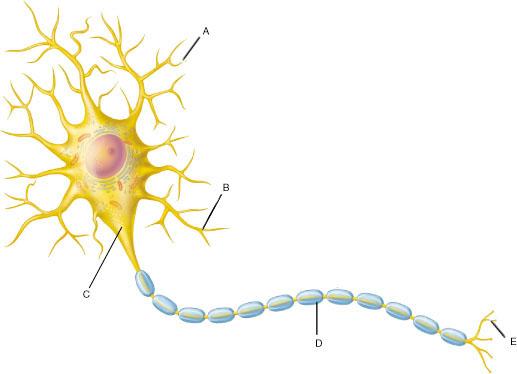
In which area of the neuron is an action potential initially generated?
C
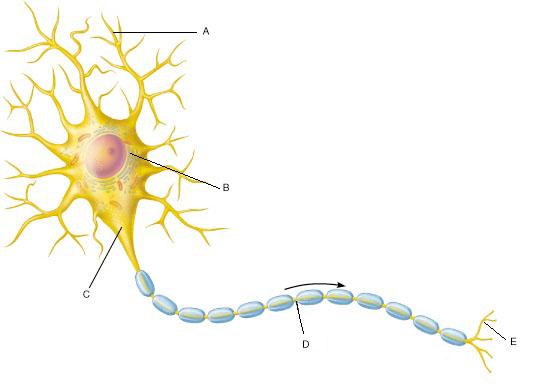
Which of the following membrane regions would have significant numbers of voltage-gated Na and K ion channels?
C and D
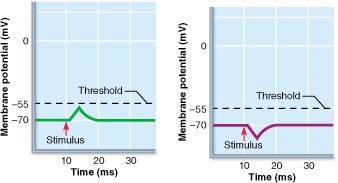
Which of the following statements is true of both membrane potential responses shown in the graphs?
Both responses are examples of graded potentials.
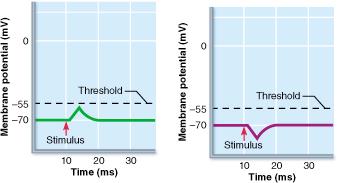
Which result of the stimulus applied is the likely cause of the response observed in the left graph?
opening of gated Na+ channels
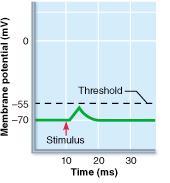
Which of the following is expected to occur first if the membrane potential increase shown in the graph were to reach the threshold value indicated at -55 mV?
opening of voltage gated Na+ channels
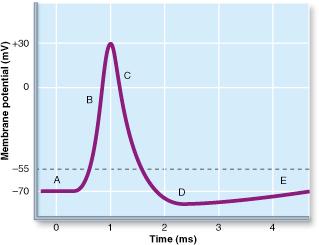
What change in a neuron is being measured in the graph?
the voltage measured across the axon membrane at a specific point as an action potential travels past
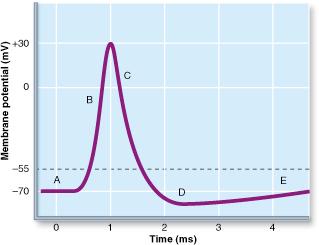
At which point of the illustrated action potential are the most gated Na+ channels open?
B
The __________ is due to the difference in K+ and Na+ concentrations on either side of the plasma membrane, and the difference in permeability of the membrane to these ions.
resting membrane potential
intermittent membrane potential
dendrite potential
active potential
resting membrane potential
What type of stimulus is required for an action potential to be generated?
a threshold level depolarization
multiple stimuli
hyperpolarization
a suprathreshold stimulus
a threshold level depolarization
Which of the following is NOT a difference between graded potentials and action potentials?
Graded potentials can result from the opening of chemically gated channels; action potentials require the opening of voltage-gated channels.
Greater stimulus intensity results in larger graded potentials, but not larger action potentials.
Spatial summation is used to increase the amplitude of a graded potential; temporal summation is used to increase the amplitude of an action potential.
Graded potentials occur along dendrites, whereas action potentials occur along axons.
Spatial summation is used to increase the amplitude of a graded potential; temporal summation is used to increase the amplitude of an action potential
Which of the following is a factor that determines the rate of impulse propagation, or conduction velocity, along an axon?
whether the axon is located in the central nervous system or in the peripheral nervous system
degree of myelination of the axon
the number of axon collaterals extending from a truncated axon
length of the axon
degree of myelination of the axon
The sodium-potassium pump ejects two Na+ from the cell and then transports three K+ back into the cell in order to maintain the concentration gradients for sodium and potassium.
True
False
F
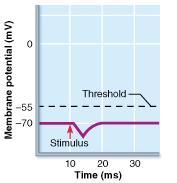
Which of the following is true regarding a response to an excitatory event which might occur soon after the initial stimulus indicated in the graph?
An excitatory event may result in an action potential, but this will be less likely if the excitatory stimulus occurs during the response to the stimulus observed in the graph
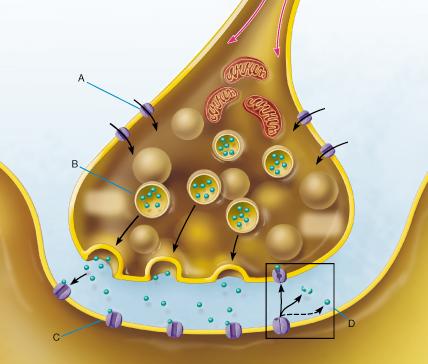
What event is depicted in the structure labeled A?
movement of Ca2+ into the interior of the axonal terminus through voltage-gated channels
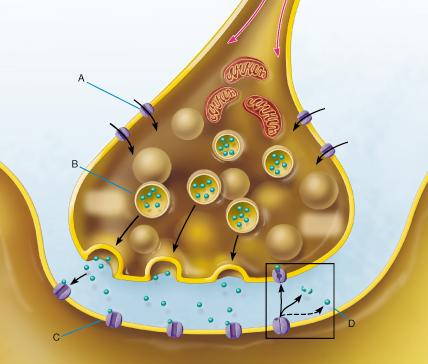
Which of the following most accurately describes the involvement of the structure labeled B in synaptic signaling?
release of neurotransmitter into the synaptic cleft by exocytosis
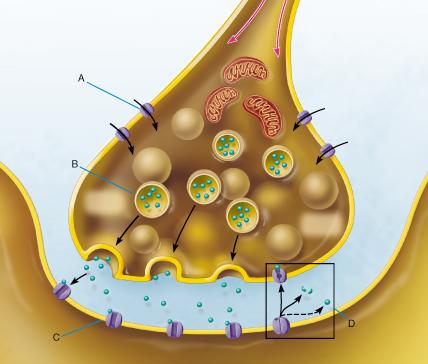
Which of the following statements most accurately describes the effects caused by binding of the ligand shown to the structure labeled C?
The membrane potential of the postsynaptic membrane changes
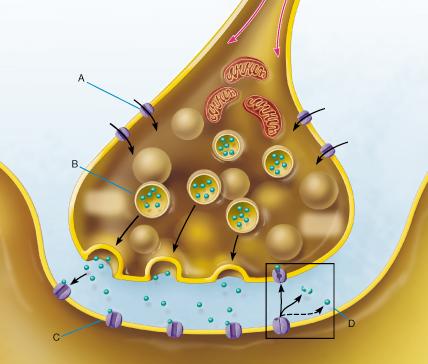
The box labeled D illustrates three mechanisms by which the effects of a neurotransmitter may be terminated. Which of the following mechanisms is NOT included in the figure?
reuptake of the neurotransmitter by transport into the postsynaptic cell
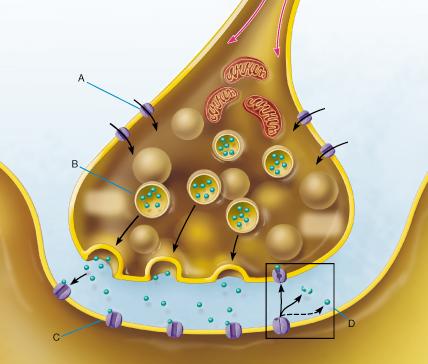
Signals generated at a chemical synapse are said to move only in the direction of the presynaptic cell to the postsynaptic cell. Which of the following statements regarding the mechanisms determining this one way transmission is INCORRECT?
Ions diffusing out of the presynaptic cell can enter the postsynaptic cell, but cannot reenter the presynaptic cell.
Which membrane potential occurs because of the influx of Na+ through chemically gated channels in the receptive region of a neuron?
inhibitory action potential
action potential
inhibitory postsynaptic potential
excitatory postsynaptic potential
excitatory postsynaptic potential
Which of the following is NOT true of an electrical synapse?
They are less common than chemical synapses.
They are specialized for release and reception of chemical neurotransmitters.
Communication through these synapses may be unidirectional or bidirectional.
Transmission across these synapses is very rapid.
They are specialized for release and reception of chemical neurotransmitters
Opening K+ or Cl- channels in a postsynaptic membrane would produce an inhibitory postsynaptic potential (IPSP).
True
False
T
Which neurotransmitter(s) is/are the body's natural pain killer?
endorphins
acetylcholine
substance P
norepinephrine
endorphins
Which of the following is NOT one of the chemical classes into which neurotransmitters fall?
peptides
chlorides
amino acids
gases and lipids
chlorides
Which neuron circuit pattern is involved in the control of rhythmic activities such as breathing?
diverging circuit
reverberating circuit
converging circuit
parallel after-discharge circuit
reverberating circuit
What component of the reflex arc determines the response to a stimulus?
receptor
integration center
effector
sensory neuron
integration center
Which of the following is NOT a type of circuit?
diverging circuits
pre-discharge circuits
reverberating circuits
converging circuits
pre-discharge circuits
Which of the following circuit types is involved in the control of rhythmic activities such as the sleep-wake cycle, breathing, and certain motor activities (such as arm swinging when walking)?
diverging circuits
reverberating circuits
parallel after-discharge circuits
converging circuits
reverberating circuits
Which pattern of neural processing works in a predictable, all-or-nothing manner, where reflexes are rapid and automatic responses to stimuli in which a particular stimulus always causes the same response?
serial processing
reflexive processing
oscillative processing
parallel processing
serial processing
Efferent nerve fibers may be described as motor nerve fibers.
True
False
T
Which of the choices below describes the ANS?
sensory neurons that convey information from somatic receptors in the head, body wall, and limbs and from receptors from the special senses of vision, hearing, taste, and smell to the CNS
sensory and motor neurons that supply the digestive tract
motor fibers that conduct nerve impulses from the CNS to smooth muscle, cardiac muscle, and glands
motor fibers that conduct nerve impulses from the CNS to skeletal muscles
motor fibers that conduct nerve impulses from the CNS to smooth muscle, cardiac muscle, and glands
Which of the following describes the nervous system integrative function?
responds to stimuli by gland secretion or muscle contraction
analyzes sensory information, stores information, makes decisions
senses changes in the environment
analyzes sensory information, stores information, makes decisions
Which of the following is not a function of the autonomic nervous system?
innervation of skeletal muscle
innervation of smooth muscle of the digestive tract
innervation of cardiac muscle
innervation of glands
innervation of skeletal muscle
The overlapping functions of the nervous system are sensory input, integration, and motor output.
True
False
T
The autonomic nervous system is under voluntary control; whereas, the somatic nervous system is involuntary.
True
False
F
The term central nervous system refers to the ________.
peripheral and spinal nerves
brain, spinal cord, and peripheral nerves
brain and spinal cord
spinal cord and spinal nerves
brain and spinal cord
Cell bodies of sensory neurons may be located in ganglia lying outside the central nervous system.
True
False
T
Myelination of the nerve fibers in the central nervous system is the job of the oligodendrocyte.
True
False
True
Neurons in the CNS are organized into functional groups.
True
False
T
The oligodendrocytes can myelinate several axons.
True
False
T
The nodes of Ranvier are found only on myelinated, peripheral neuron processes.
True
False
F
Unipolar neurons have axons structurally divided into peripheral and central processes.
True
False
T
f bacteria invaded the CNS tissue, microglia would migrate to the area to engulf and destroy them.
True
False
T
Which of the following is not a function of astrocytes?
control the chemical environment around neurons
provide the defense for the CNS
anchor neurons to blood vessels
support and brace neurons
guide the migration of young neurons, synapse formation, and helping to determine capillary permeability
provide the defense for the CNS
What are ciliated CNS neuroglia that play an active role in moving the cerebrospinal fluid called?
oligodendrocytes
Schwann cells
astrocytes
ependymal cells
ependymal cells
Bipolar neurons are commonly ________.
called neuroglial cells
found in ganglia
found in the retina of the eye
motor neurons
found in the retina of the eye
The part of a neuron that conducts impulses away from its cell body is called a(n) ________.
Schwann cell
neurolemma
axon
dendrite
axon
Collections of nerve cell bodies outside the central nervous system are called ________.
ganglia
nerves
nuclei
tracts
ganglia
A neuron that has as its primary function the job of connecting other neurons is called a(n) ________.
afferent neuron
association neuron
efferent neuron
glial cell
association neuron
Neuroglia that control the chemical environment around neurons by buffering potassium and recapturing neurotransmitters are ________.
astrocytes
oligodendrocytes
Schwann cells
microglia
astrocytes
Schwann cells are functionally similar to ________.
ependymal cells
microglia
astrocytes
oligodendrocytes
oligodendrocytes
Which of the following is not characteristic of neurons?
They have an exceptionally high metabolic rate.
They have extreme longevity.
They conduct impulses.
They are mitotic.
They are mitotic.
The all-or-none phenomenon as applied to nerve conduction states that the whole nerve cell must be stimulated for conduction to take place.
True
False
F
During depolarization, the inside of the neuron's membrane becomes less negative.
True
False
T
Strong stimuli cause the amplitude of action potentials generated to increase.
True
False
F
A postsynaptic potential is a graded potential that is the result of a neurotransmitter released into the synapse between two neurons.
True
False
T
Large-diameter nerve fibers conduct impulses much faster than small-diameter fibers.
True
False
T
The period after an initial stimulus when a neuron is not sensitive to another stimulus is the ________.
absolute refractory period
repolarization
resting period
depolarization
absolute refractory period
Which ion channel opens in response to a change in membrane potential and participates in the generation and conduction of action potentials?
mechanically gated channel
voltage-gated channel
leakage channel
ligand-gated channel
voltage-gated channel
Nerve cell adhesion molecules (N-CAMs) ________.
are found on "pathfinder" neurons
are crucial for the development of neural connections
are crucial in the production of neurotransmitters
release nerve growth factor
are crucial for the development of neural connections
Reflexes are rapid, automatic responses to stimuli.
True
False
T
Which of the following neurotransmitters inhibits pain and is mimicked by morphine, heroin, and methadone?
acetylcholine
endorphin
serotonin
nitric oxide
endorphin
What is the role of acetylcholinesterase?
destroy ACh a brief period after its release by the axon endings
amplify or enhance the effect of ACh
act as a transmitting agent
stimulate the production of acetylcholine
destroy ACh a brief period after its release by the axon endings
Some neurotransmitters can be either excitatory or inhibitory depending upon the receptor.
True
False
T
Which of the following is not a chemical class of neurotransmitters?
nucleic acid
biogenic amine
ATP and other purines
amino acid
acetycholine
nucleic acid
The substance released at axon terminals to propagate a nervous impulse is called a(n) ________.
cholinesterase
neurotransmitter
ion
biogenic amine
neurotransmitter
Which of the following is an excitatory neurotransmitter secreted by motor neurons innervating skeletal muscle?
acetylcholine
norepinephrine
cholinesterase
gamma aminobutyric acid
acetylcholine
Enkephalins and endorphins are peptides that act like morphine.
True
False
T
Which of the following describes the excitatory postsynaptic potential?
moves membrane potential away from threshold
short distance hyperpolarization
short distance depolarization
opens K+ or Cl- channels
short distance depolarization
Which of the following correctly describes a graded potential?
voltage regulated repolarization
long distance signaling
amplitude of various sizes
voltage stimulus to initiate
amplitude of various sizes
Saltatory conduction is made possible by ________.
erratic transmission of nerve impulses
diphasic impulses
the myelin sheath
large nerve fibers
the myelin sheath
When a sensory neuron is excited by some form of energy, the resulting graded potential is called a(n) ________.
excitatory potential
postsynaptic potential
generator potential
action potential
generator potential
Which of the following is not true of graded potentials?
They are short-lived.
They increase amplitude as they move away from the stimulus point.
They can be called postsynaptic potentials.
They can form on receptor endings.
They increase amplitude as they move away from the stimulus point.
A second nerve impulse cannot be generated until ________.
all sodium gates are closed
the Na ions have been pumped back into the cell
proteins have been resynthesized
the membrane potential has been reestablished
the membrane potential has been reestablished
In what way does the interior surface of a cell membrane of a resting (nonconducting) neuron differ from the external environment? The interior is ________.
negatively charged and contains more sodium
negatively charged and contains less sodium
positively charged and contains more sodium
positively charged and contains less sodium
negatively charged and contains less sodium
If a motor neuron in the body were stimulated by an electrode placed about midpoint along the length of the axon ________.
the impulse would move to the axon terminal only
muscle contraction would occur
the impulse would spread bidirectionally
the impulse would move to the axon terminal only, and the muscle contraction would occur
the impulse would spread bidirectionally
A patient is admitted to the hospital with exacerbation of multiple sclerosis (MS). She asks the nurse "Why did this have to happen to me again? I was doing so well." Why are some forms of MS characterized by periods of remission and exacerbation?
The axons are not damaged; growing numbers of potassium channels appear spontaneously in the demyelinated fibers, allowing conduction to resume.
The myelin sheaths are damaged, and repair of the myelin sheaths results in impulse propagation resuming.
The axons are not damaged; growing numbers of sodium channels appear spontaneously in the demyelinated fibers, allowing conduction to resume.
The axons are damaged, and repair of the axons results in impulse propagation resuming.
The axons are damaged, and repair of the myelin sheath results in impulse propagation resuming.
The axons are not damaged; growing numbers of sodium channels appear spontaneously in the demyelinated fibers, allowing conduction to resume.
In myelinated axons the voltage-regulated sodium channels are concentrated at the nodes of Ranvier.
True
False
T
Axon diameter and degree of myelination determine nerve impulse conduction velocity.
True
False
T
The action potential is caused by permeability changes in the plasma membrane.
True
False
T
What does the central nervous system use to determine the strength of a stimulus?
type of stimulus receptor
origin of the stimulus
frequency of action potentials
size of action potentials
frequency of action potentials
Immediately after an action potential has peaked, which cellular gates open?
calcium
sodium
chloride
potassium
potassium
Which of the following is true about the movement of ions across excitable living membranes?
Ions always move passively across membranes.
Sodium gates in the membrane can open in response to electrical potential changes.
Ions always move actively across membranes through leakage channels.
Ions always move from an area of higher concentration to an area of lower concentration
Sodium gates in the membrane can open in response to electrical potential changes.
A stimulus traveling toward a synapse appears to open calcium ion channels at the presynaptic end, which in turn promotes fusion of synaptic vesicles to the axonal membrane.
True
False
True
An impulse from one nerve cell is communicated to another nerve cell via the ________.
effector
synapse
receptor
cell body
synapse
Which of the following is false or incorrect?
A nerve impulse occurs if the excitatory and inhibitory effects are equal.
An excitatory postsynaptic potential occurs if the excitatory effect is greater than the inhibitory effect but less than threshold.
An inhibitory postsynaptic potential occurs if the inhibitory effect is greater than the excitatory, causing hyperpolarization of the membrane.
A nerve impulse occurs if the excitatory and inhibitory effects are equal.
An inhibitory postsynaptic potential (IPSP) is associated with ________.
opening of voltage-regulated channels
a change in sodium ion permeability
lowering the threshold for an action potential to occur
hyperpolarization
hyperpolarization
Which of the following will occur when an excitatory postsynaptic potential (EPSP) is being generated on the dendritic membrane?
A single type of channel will open, permitting simultaneous flow of sodium and potassium.
Specific sodium gates will open.
Specific potassium gates will open.
Sodium gates will open first, then close as potassium gates open.
A single type of channel will open, permitting simultaneous flow of sodium and potassium.
Select the correct statement regarding synapses.
The synaptic cleft prevents an impulse from being transmitted directly from one neuron to another.
The release of neurotransmitter molecules gives cells the property of being electrically coupled.
Cells with gap junctions use chemical synapases.
Neurotransmitter receptors are located on the axons terminals of cells.
The synaptic cleft prevents an impulse from being transmitted directly from one neuron to another.